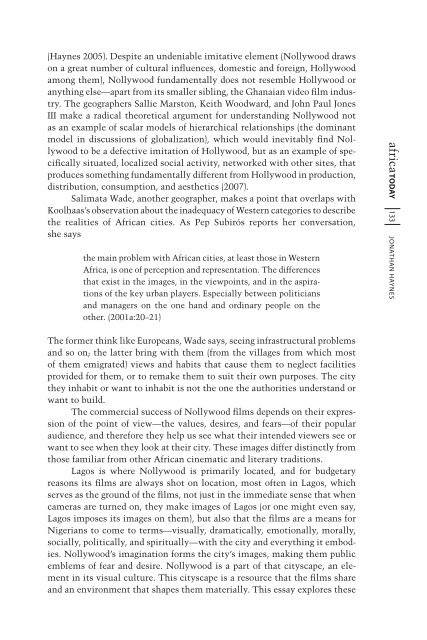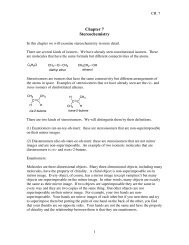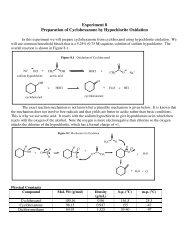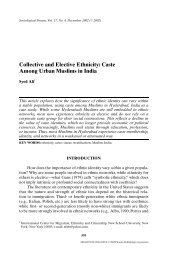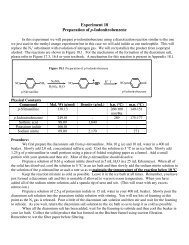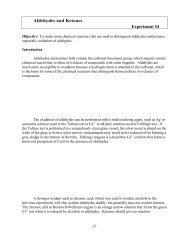Lagos is the ground of the films, not just in the sense that ... - myweb
Lagos is the ground of the films, not just in the sense that ... - myweb
Lagos is the ground of the films, not just in the sense that ... - myweb
Create successful ePaper yourself
Turn your PDF publications into a flip-book with our unique Google optimized e-Paper software.
(Haynes 2005). Despite an undeniable imitative element (Nollywood drawson a great number <strong>of</strong> cultural <strong>in</strong>fluences, domestic and foreign, Hollywoodamong <strong>the</strong>m), Nollywood fundamentally does <strong>not</strong> resemble Hollywood oranyth<strong>in</strong>g else—apart from its smaller sibl<strong>in</strong>g, <strong>the</strong> Ghanaian video film <strong>in</strong>dustry.The geographers Sallie Marston, Keith Woodward, and John Paul JonesIII make a radical <strong>the</strong>oretical argument for understand<strong>in</strong>g Nollywood <strong>not</strong>as an example <strong>of</strong> scalar models <strong>of</strong> hierarchical relationships (<strong>the</strong> dom<strong>in</strong>antmodel <strong>in</strong> d<strong>is</strong>cussions <strong>of</strong> globalization), which would <strong>in</strong>evitably f<strong>in</strong>d Nollywoodto be a defective imitation <strong>of</strong> Hollywood, but as an example <strong>of</strong> specificallysituated, localized social activity, networked with o<strong>the</strong>r sites, <strong>that</strong>produces someth<strong>in</strong>g fundamentally different from Hollywood <strong>in</strong> production,d<strong>is</strong>tribution, consumption, and aes<strong>the</strong>tics (2007).Salimata Wade, ano<strong>the</strong>r geographer, makes a po<strong>in</strong>t <strong>that</strong> overlaps withKoolhaas’s observation about <strong>the</strong> <strong>in</strong>adequacy <strong>of</strong> Western categories to describe<strong>the</strong> realities <strong>of</strong> African cities. As Pep Subirós reports her conversation,she says<strong>the</strong> ma<strong>in</strong> problem with African cities, at least those <strong>in</strong> WesternAfrica, <strong>is</strong> one <strong>of</strong> perception and representation. The differences<strong>that</strong> ex<strong>is</strong>t <strong>in</strong> <strong>the</strong> images, <strong>in</strong> <strong>the</strong> viewpo<strong>in</strong>ts, and <strong>in</strong> <strong>the</strong> aspirations<strong>of</strong> <strong>the</strong> key urban players. Especially between politiciansand managers on <strong>the</strong> one hand and ord<strong>in</strong>ary people on <strong>the</strong>o<strong>the</strong>r. (2001a:20–21)africa today 133 Jonathan HaynesThe former th<strong>in</strong>k like Europeans, Wade says, see<strong>in</strong>g <strong>in</strong>frastructural problemsand so on; <strong>the</strong> latter br<strong>in</strong>g with <strong>the</strong>m (from <strong>the</strong> villages from which most<strong>of</strong> <strong>the</strong>m emigrated) views and habits <strong>that</strong> cause <strong>the</strong>m to neglect facilitiesprovided for <strong>the</strong>m, or to remake <strong>the</strong>m to suit <strong>the</strong>ir own purposes. The city<strong>the</strong>y <strong>in</strong>habit or want to <strong>in</strong>habit <strong>is</strong> <strong>not</strong> <strong>the</strong> one <strong>the</strong> authorities understand orwant to build.The commercial success <strong>of</strong> Nollywood <strong>films</strong> depends on <strong>the</strong>ir expression<strong>of</strong> <strong>the</strong> po<strong>in</strong>t <strong>of</strong> view—<strong>the</strong> values, desires, and fears—<strong>of</strong> <strong>the</strong>ir popularaudience, and <strong>the</strong>refore <strong>the</strong>y help us see what <strong>the</strong>ir <strong>in</strong>tended viewers see orwant to see when <strong>the</strong>y look at <strong>the</strong>ir city. These images differ d<strong>is</strong>t<strong>in</strong>ctly fromthose familiar from o<strong>the</strong>r African c<strong>in</strong>ematic and literary traditions.<strong>Lagos</strong> <strong>is</strong> where Nollywood <strong>is</strong> primarily located, and for budgetaryreasons its <strong>films</strong> are always shot on location, most <strong>of</strong>ten <strong>in</strong> <strong>Lagos</strong>, whichserves as <strong>the</strong> <strong>ground</strong> <strong>of</strong> <strong>the</strong> <strong>films</strong>, <strong>not</strong> <strong>just</strong> <strong>in</strong> <strong>the</strong> immediate <strong>sense</strong> <strong>that</strong> whencameras are turned on, <strong>the</strong>y make images <strong>of</strong> <strong>Lagos</strong> (or one might even say,<strong>Lagos</strong> imposes its images on <strong>the</strong>m), but also <strong>that</strong> <strong>the</strong> <strong>films</strong> are a means forNigerians to come to terms—v<strong>is</strong>ually, dramatically, emotionally, morally,socially, politically, and spiritually—with <strong>the</strong> city and everyth<strong>in</strong>g it embodies.Nollywood’s imag<strong>in</strong>ation forms <strong>the</strong> city’s images, mak<strong>in</strong>g <strong>the</strong>m publicemblems <strong>of</strong> fear and desire. Nollywood <strong>is</strong> a part <strong>of</strong> <strong>that</strong> cityscape, an element<strong>in</strong> its v<strong>is</strong>ual culture. Th<strong>is</strong> cityscape <strong>is</strong> a resource <strong>that</strong> <strong>the</strong> <strong>films</strong> shareand an environment <strong>that</strong> shapes <strong>the</strong>m materially. Th<strong>is</strong> essay explores <strong>the</strong>se


